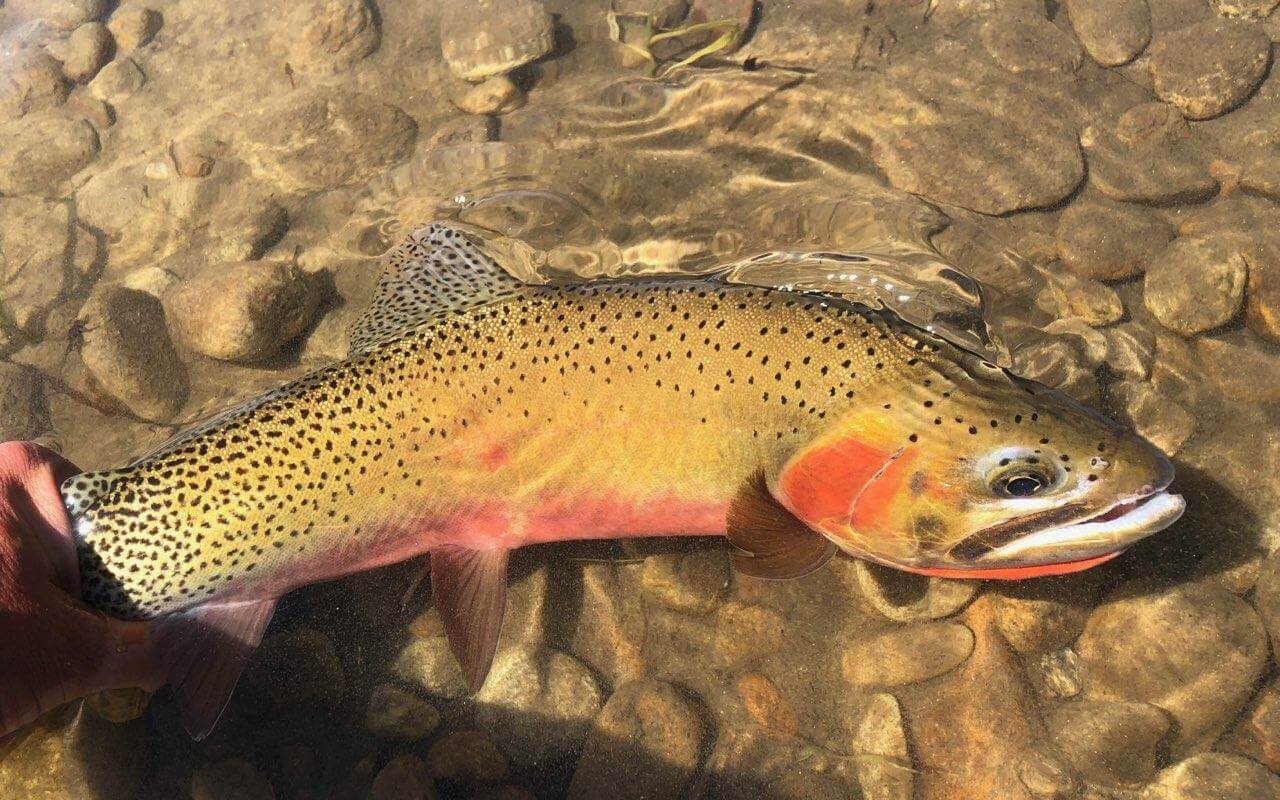
Cutthroat trout, also known as the “Lord of the Waters,” are a fascinating species of fish that can be found in various freshwater habitats across North America. With their distinctive red or orange markings on the underside of their lower jaws, these beautiful trout are easily recognized and admired by anglers and nature enthusiasts alike.
In this article, we will delve into the world of cutthroat trout and uncover 18 interesting facts about these remarkable fish. From their unique adaptations to their diverse range, we will explore the many facets that make cutthroat trout such a captivating species. So, let’s dive into the depths of the water and discover the captivating world of cutthroat trout!
Key Takeaways:
- Cutthroat trout are iconic fish native to western North America, known for their vibrant colors and unique spawning rituals. They play a vital role in maintaining the ecological balance of their ecosystems.
- Conservation efforts are crucial to protect and restore habitats for cutthroat trout, ensuring their survival for future generations. Their sport fishing popularity has led to regulated fishing seasons and size limits.
The Name Says It All
The cutthroat trout gets its name from the distinctive red or orange slashes located on the underside of its lower jaw. These markings resemble the slashes left by a knife or razor, giving it the appearance of a cut throat.
Native to Western North America
Originally found in the rivers and lakes of the western region of North America, cutthroat trout are considered an iconic species of the Rocky Mountain region.
Diverse Coloration
Cutthroat trout exhibit a wide range of colors, from silver and gray in freshwater to bright red, orange, and gold hues during spawning season. This stunning variety of coloration makes them a visually striking species.
Feeding Habits
Cutthroat trout are opportunistic predators, feeding on a variety of organisms including insects, crustaceans, small fish, and even small mammals like mice or voles.
Unique Spawning Rituals
During breeding season, female cutthroat trout create a nest, or redd, by using their tails to clear away debris and gravel from the riverbed. They then deposit their eggs in the redd, and the male fertilizes them by releasing his milt.
Anadromous Behavior
Some populations of cutthroat trout exhibit anadromous behavior, meaning they migrate from freshwater to saltwater and back again. These migratory trout are known as steelhead.
Saline Tolerance
Cutthroat trout have the unique ability to tolerate varying levels of salinity. This adaptability allows them to thrive in both freshwater and brackish water environments.
Longevity
With proper habitat conditions, cutthroat trout can live up to 7 or 8 years. However, some individuals have been known to survive for over 10 years.
Native American Symbolism
Cutthroat trout hold cultural significance for many Native American tribes in the western United States. They are often seen as a symbol of strength, adaptability, and resilience.
Conservation Concerns
Due to habitat degradation, overfishing, and the introduction of non-native species, many populations of cutthroat trout are now at risk. Efforts are being made to protect and restore their natural habitats.
State Fish
The cutthroat trout is the official state fish of several western U.S. states, including Montana, Wyoming, and Colorado.
Hybridization
Hybridization can occur between cutthroat trout and other trout species, such as rainbow trout or brook trout. This can lead to the dilution of pure populations of cutthroat trout.
Fly Fishing Favorite
Due to their aggressive nature and strong fighting abilities, cutthroat trout are highly sought after by fly anglers. They provide an exhilarating experience for those who enjoy the art of fly fishing.
Environmental Indicators
As a native species, cutthroat trout play a vital role in maintaining the ecological balance of their ecosystems. Their presence or absence can reflect the overall health of the aquatic environment.
Conservation Efforts
Various conservation organizations and agencies are actively engaged in efforts to protect and restore habitats for cutthroat trout, ensuring their survival for future generations.
Popular Game Fish
Cutthroat trout are highly regarded as a game fish, providing both recreational and economic value to communities near their native waters. Their sport fishing popularity has led to regulated fishing seasons and size limits.
Unique Species Adaptations
Individual populations of cutthroat trout have adapted to their specific environments, resulting in distinct subspecies like the Lahontan cutthroat trout, Yellowstone cutthroat trout, and Westslope cutthroat trout.
Revered by Anglers
Anglers who have had the pleasure of catching a vibrant and acrobatic cutthroat trout often develop a lifelong appreciation for these captivating fish.
Overall, the 18 Cutthroat Trout Facts demonstrate the remarkable nature of this species. From their name and unique markings to their diverse habitats and cultural significance, cutthroat trout continue to captivate our imagination and remind us of the beauty found in our natural world.
Conclusion
Cutthroat trout are fascinating and highly adaptable fish species that thrive in a variety of environments. With their distinctive appearance and unique behaviors, they have captured the interest of both anglers and nature enthusiasts alike. From their historic significance as one of the first fish species to be recorded in North America to their ability to survive in harsh conditions, cutthroat trout continue to inspire awe and admiration.
Understanding the various facts about cutthroat trout helps to appreciate their importance in aquatic ecosystems and ensures their conservation for future generations.
FAQs
1. What is the habitat of cutthroat trout?
Cutthroat trout are found in a range of habitats, including rivers, streams, and lakes in North America, particularly in the western United States.
2. How do cutthroat trout get their name?
Cutthroat trout have a distinct red or orange slash mark on the lower jaw, which resembles a severed throat, giving them their unique name.
3. What do cutthroat trout eat?
Cutthroat trout are opportunistic feeders and consume a diverse diet, including insects, crustaceans, small fish, and even small mammals.
4. How large do cutthroat trout grow?
The maximum size of cutthroat trout varies depending on the subspecies, but they can grow up to 20 inches (50 cm) in length and weigh over 5 pounds (2.3 kg).
5. Can you catch and release cutthroat trout?
Yes, catch and release fishing practices are commonly employed for cutthroat trout to ensure the conservation of the species and their populations in various water bodies.
6. Are cutthroat trout endangered?
Certain subspecies of cutthroat trout are classified as endangered or threatened, primarily due to habitat degradation, pollution, and overfishing. Conservation efforts are in place to protect and restore their populations.
7. Are cutthroat trout good for eating?
Cutthroat trout are known for their excellent taste and are often valued by anglers and seafood enthusiasts for their flavorful, tender flesh.
8. Can cutthroat trout be found in saltwater?
While cutthroat trout are primarily freshwater fish, some subspecies, such as the coastal cutthroat trout, have the ability to enter the brackish waters of estuaries and can tolerate low levels of salinity.
9. How long do cutthroat trout live?
The lifespan of cutthroat trout can vary depending on the subspecies and environmental conditions but typically ranges from 6 to 10 years.
10. Do cutthroat trout migrate?
Yes, cutthroat trout can exhibit both resident and migratory patterns, depending on their habitat and the availability of resources such as food and spawning areas.
Was this page helpful?
Our commitment to delivering trustworthy and engaging content is at the heart of what we do. Each fact on our site is contributed by real users like you, bringing a wealth of diverse insights and information. To ensure the highest standards of accuracy and reliability, our dedicated editors meticulously review each submission. This process guarantees that the facts we share are not only fascinating but also credible. Trust in our commitment to quality and authenticity as you explore and learn with us.


